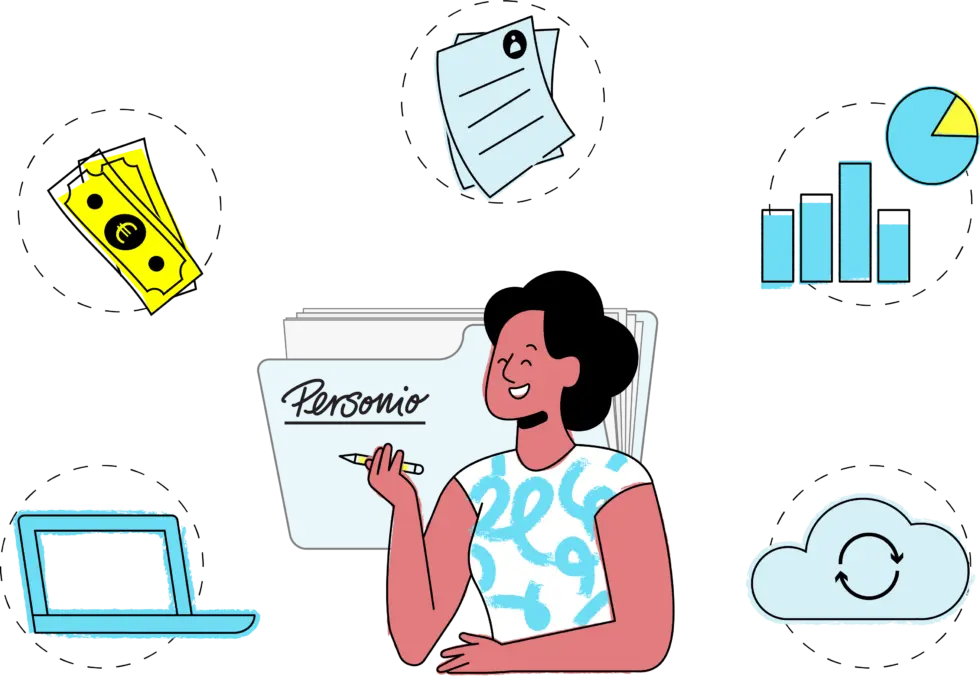The change management process doesn’t have to be complex, but it does have to be effective. For introducing change into your org, and making it last, there are some key steps you need to take and simply can’t miss.
So, how do you make the process and how do you manage it? In this article, we’ll cover the steps in the change management process, relevant examples, and templates to use. And, some best practices to make change stick.
Change may need to start with your HR software. Download our guide to switching systems today.
Contents
What Is A Change Management Process?
Why Do Change Management Processes Matter for HR Professionals?
Who Is Responsible For Making Change Management Work?
How Does an Effective Change Management Process Work?
Change Management Process Example: Booking Annual Leave
How Can You Tell If A Change Management Process Is Working?
Change Management Processes Made Simple
What Is The Change Management Process?
If change management is the art and science of managing change, then change management processes are what help support and facilitate that art and science. That means determining ways, unique to your organization, that you can support change with employees, within teams, or as part of your overall department structure.
In short, working toward some kind of change management framework typically involves three key elements:
- People: Helping them adapt to change.
- Processes: Making change happen smoothly.
- Technology: Automating change to make it stick.
Why Do Change Management Processes Matter for HR Professionals?
Simply put, because HR processes lay the foundation for operational excellence. After all, change is not the end goal, but an ‘end state’ that can help power organizations toward a goal (a better bottom line, higher retention, motivation, etc.). Processes and models help pave the way.
For example, in order to store and use all HR documents digitally, HR leaders might have to encourage employees and managers to change their processes. The change is ‘store CVs in a central location, not in a filing cabinet,’ but the broader goal is ‘going digital.’
Change is also different from transformation. Transformation is about making much bigger, broader change possible – across the whole organization. Sometimes change can be as small as asking people to recycle.
Less Paperwork, More People Work
Make time for more strategic, people-focused HR thanks to seamless core processes. Try Personio today.
Who Is Responsible For Making Change Management Work?
Change management, as a matter of process, usually rests within HR. While the idea of change may be set out from the top down or a reaction to greater market trends, the processes that help us get there rest in the hands of HR. Why? Because HR is most in tune with people, and people are imperative to change.
While C-level executives should be accountable for managing the changes themselves (and the results this change brings), particularly for bigger projects, HR can be responsible for ensuring their company follows a strong, stable, well-thought-out change management process.
How Does an Effective Change Management Process Begin?
In essence, to get people to change you need to go from one ‘state’ to another. Going through that process can be a challenge. Kurt Lewin, for example, describes people as needing to ‘unfreeze, change, and refreeze.’
Another model, by John Kotter, illustrates eight steps typically involved in the change management process:
- Create a sense of urgency (make it important)
- Build a guiding coalition (gathering people to lead change)
- Form a strategic vision and initiatives (describe why and how to change)
- Enlist a volunteer army (you can’t do it on your own!)
- Enable action by removing barriers (make it easy)
- Generate short-term wins (help people see progress being made)
- Sustain acceleration (if it takes too long, they’ll get bored and frustrated)
- Institute change (make it impossible to go back to ‘the way it was before’)
However, of the most popular models these days – and possibly the easiest to understand and implement – is the ADKAR model. ADKAR is, quite simply, the acronym we’ve spelled out below:
- A – awareness of the need to change
- D – desire to support the change
- K – knowledge of how to change
- A – ability to demonstrate skills and behaviors
- R – reinforcement to make the change stick
The people who came up with the ADKAR model – a group called Prosci – also provide a helpful three-phase process for managing change. They suggest that you begin by preparing for it, then manage the process, then reinforce change.
It may sound simple but, as in the case of any successful project, the devil is in the details so we’ve provided an example of how to get employees to complete their leave requests early to illustrate this point…
Is Change Management On Your Mind?
Allow us to help start the conversation. Download our guide to change management today, and learn how to implement it successfully for the benefit of your bottom line. Download it for free today.
Change Management Process Example: Booking Annual Leave
Using the ADKAR model and the three-phases of change, here is an example of how to build an effective change management process in your organization…
Phase 1: Awareness
In Phase 1, start by preparing for change. Prosci says we should ‘identify anticipated points of resistance, define our change management strategy, prepare our team, and develop our sponsorship model.’
In this example, let’s begin by getting Awareness. We might already know that employees don’t like completing leave requests, because their managers haven’t required them to do it in the past. They also don’t see how it’s helpful to the business to do it far in advance, and they think it is their right to take leave whenever they want.
So, they’re likely to resist the change or ignore a request to put their leave information in earlier.
Phase 2: Desire and Knowledge
In Phase 2 we should manage change, possibly by creating a ‘resistance management plan’ and then take action and implement the steps.
In the case of encouraging people to book annual leave sooner, there probably isn’t a need for a complex strategy, team, or sponsorship model. Let’s keep things simple.
For example: let’s create a Desire to support the change. The CEO could simply send an email to all employees explaining that booking leave in advance isn’t just helpful to the company. It also helps plan when to have important company meetings and make sure there are always the right numbers of people available to serve customers. It’s also important for people’s mental health and wellbeing that they take all their leave.
They could share Knowledge about the importance of encouraging staff to take annual leave. Point out that the average employee takes just 62% of their allowance in the UK, this is bad because it costs the country around £77.5 billion a year in lost productivity due to mental and physical ill-health, often caused by stress.
Phase 3: Ability and Reinforcement
Then comes Phase 3. This is the time to demonstrate how people are able to make the change, and then reinforce this behavior. By collecting and analyzing feedback we can diagnose gaps, manage resistance, and then implement corrective actions, and celebrate success.
For example, we might find that, despite our CEO’s email, people still are not booking holiday in advance. It might be because they don’t have the Ability to do it.
By changing the tools that people use to record leave to have a single sign-on that is approvable on an app, for example, it might be possible to reduce resistance to booking leave.
But people still might not book, because they want to have the option to change their minds. Giving people the Ability to change leave up to a certain period of time in advance might help encourage people to commit to booking it (even if they have to change it).
Then Reinforcing this behavior by mandating it – if necessary – can make this behavior the new norm. For example, employees might be told that they will lose certain fringe benefits if they don’t book their leave in advance – which will certainly change their behavior. In extreme cases (probably not necessary in this example) leaders can actually tie change to people’s Key Performance Indicators (KPIs), so they won’t get bonuses unless they change their behavior.
How Can You Tell If A Change Management Process Is Working?
Organizations that have a better sense of business resilience are also generally able to handle change better.
In addition, companies who are able to use HR analytics and reporting for strategic decisions can also test certain changes on a smaller scale, get results, and roll them out to a broader audience in a more agile and data-informed way.
In addition, HR teams in the UK who work with digital solutions to support their administration and reporting are also better able to master crises, according to an HR study conducted by Bitkom and Personio. They also tend to be strategically better prepared for subsequent recovery.
Change Management Processes Made Simple
While change management processes can be complex, they don’t have to be. The key is simply to give the change a bit of thought.
People need enough time to make the change happen, a reason to do it, and a way to make it as easy as possible. While McKinsey & Company say that, “70 percent of change programs fail to achieve their goals, largely due to employee resistance and lack of management support,” even the most complex change – even complete digital transformation – is possible when it’s planned well and people feel like they’re supported along the way.
So if you’re ready to change your HR processes and go digital, consider discovering Personio today. We know a lot about effective change management processes, and we’re very happy to help you through your own journey.
No Hoops, No Hype
Just Great HR







